
Photograph: Jeff Sciortino

Nate Berkus is feeling Gustavian today. As in King Gustav III, the 18th-century monarch who reigned during the golden age of design in Sweden. Actually, Berkus, 35, was feeling Gustavian at least four months ago when he started designing his 2007 spring collection for Linens ‘n Things. But today he is providing a rare glimpse into the design process for his merchandise line, and he is still, as he would say, feeling the Gustavian vibe.
“Which means I’m feeling a return to simplicity where historic materials take a casual, airy direction,” says Berkus. “I see floorboards painted milk white, chalky walls, and sunshine streaming in from every direction. A tone-on-tone palette, where the only color is from a bright bouquet of flowers and the green grass.”
That’s quite a feeling. But when Berkus designs, or even just speaks, millions of people listen-and buy. Twelve years ago, he was making a nice living in Chicago as a designer. He did tony private residences and chic commercial gigs like W Hotels and Barneys New York. Several pieces of his furniture were being sold in trade-only design marts on the East and West coasts. He worked hard, and he smiled his megawatt smile and he started building a reputation as a knowledgeable, nice young man who had a decorating style based on eclectic, textured juxtapositions. But then Oprah Winfrey invited him on one of her shows, and a design star-albeit one with the bashful enthusiasm of a puppy dog and a vocabulary that veers dangerously close to Valley Guy-was born.
Today, five years after his first appearance on The Oprah Winfrey Show, Berkus is one of the preeminent designers in the United States. He appears regularly on Oprah and in her magazine O at Home. In 2005, he published a book, Home Rules: Transform the Place You Live into a Place You’ll Love (Hyperion), and every time he appeared at a store for a signing, the crowds reacted as if he were a rock star. “When Nate showed up at the Mall of America [in Bloomington, Minnesota] for a book signing, it was a total mob scene,” says Will Schwalbe, a senior vice president and the editor-in-chief of Hyperion. “More than 500 people were there-some had been waiting for hours, and some had flown in just to see Nate.”
|
Nineteen months ago, when he launched his own line of home decorating products for Linens ‘n Things, the Nate Berkus collection represented the largest brand introduction in the retailer’s history. The 600 items, which are updated every spring and fall, can be found in more than 500 Linens ‘n Things stores in 47 states and six Canadian provinces. “We find the brand has resonated with our customers,” says Bob DiNicola, the chief executive officer of Linens ‘n Things. “Nate’s vision has been an exciting addition for us.”
The Berkus headquarters are in an old warehouse on the city’s Near West Side. Thanks to the presence of the Jewell Events Catering building a block away and other service companies in the neighborhood, there is no street parking anywhere. Berkus’s ten employees have to park in the side alley and hope for the best. Inside, the building has been gutted and redone in the style of minimalist heaven. A few antiques mingle with the clean lines of light wood. The open staircase to the second floor is hell on the women who work here; how are they supposed to run up and down that in their stilettos? But the staff members are allowed to bring their dogs to work every day.
Seated at a cerused oak table in his conference room, Berkus and Tara Shade, his creative director, try to explain how this spring became Gustavian.
“To design a collection, first we talk about what the feeling is,” says Berkus. “Is it old library? Is it romance? Is it Hollywood glamour? Or is it Swedish country manor? We start conceptually, and we talk it out.”
“He is very good at conceptualizing as he talks,” says Shade. Inspiration comes from Berkus’s travels, Shade’s attendance at the Paris fashion shows, and their mutual love of shopping at flea markets.
“It goes from concept to feelings to specific materials,” says Berkus. He puts together style guides for Linens ‘n Things: collages of samples-fabrics, photos, décors, paint colors-and then they are sent to the company.

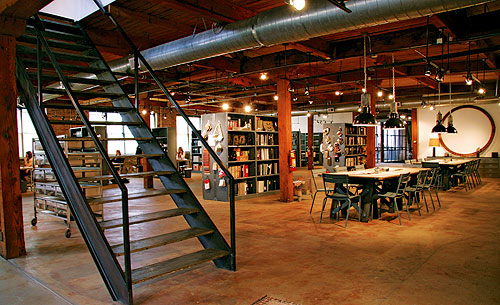
At Berkus’s minimalist headquarters in an old warehouse on the Near West Side, antiques mingle with light wood.
Photograph: Megan Lovejoy
The result this spring is a pale monochromatic look: wheat and cream and ecru and white plus small touches of chocolate brown. “I love this pale-on-pale look,” says Berkus. “It’s about giving people a way to live within the collection that doesn’t dictate to them. You can go 20 different directions here.” Behind him is a display of items from his spring collection, and he starts playing with them. There is a pillow resembling a Bottega Veneta purse: a weaving of rough-edged faux leather strips (“We were so ahead of the curve on using rough edges,” says Berkus); and there is a pillow with a flower burst of large crystals in the center (“Very Andy Warhol,” he says. “If I had a boring sofa, I’d buy this”). There is a beautiful quilt patterned with medallions suitable for the Taj Mahal, unlined linen curtains with deliberately frayed hems, sheet-and-towel sets with Berkus’s signature rectangular chainlink logo embroidered on the edges.
“This time everything turned out perfectly, but sometimes things start to go wrong,” says Berkus. “And I’m not great when that happens. If the company says to me, ‘Oh, this pillow? If you really want to do the whole thing as a handwoven item, then we’ll have to go with a less expensive filling’-and I’ll say no.” He pauses, running his hands through his hair. “You have to have one consistent vision, and even though there is a room full of opinions and talent and knowledge, it doesn’t matter. There has to be one consistent vision. Because the minute you start making concessions-because this is going to cost too much when it gets to the store, or we can’t use this material because the vendor is involved in another collection-then it all goes bad.”
He doesn’t want to be involved in bad, for any number of reasons: his vision, his standards, his reputation.
“And I like to be liked,” he says. “I like to be the one in the room everyone likes. But it became clear to me early on in this process of designing a product line that being respected was more important than being liked. So sometimes I have to think, Grow up and say that some sample missed the mark. It doesn’t matter that the rep made a 40-hour trip to India and back getting it done if I don’t like what’s there.”
So it isn’t always easy being a design guru?
Berkus rolls his earnest blue eyes. “Sometimes it’s really hard.”
* * *
|
He was born in Los Angeles, one of four children. His father, Michael Berkus, is a sports-marketing consultant, and his mother, Nancy Gold-en, is an interior decorator who showed an early flair for design. Nate began helping her rearrange the living-room furniture when he was in grade school. “When I was 12 years old, I got my own bedroom,” he says, “and the little details mattered so much to me, like the stripe in the material was one-quarter inch wide. Why did it have to be like that? I wanted it to be an inch wide.”
He came by this naturally. When his mother was eight years old, she became adamant about getting the correct shade of lavender for her bedroom walls. In second grade, she rejected the gift of a purse, saying she could tell by the smell that it wasn’t real leather. When Berkus’s parents divorced, his mother moved with the children to a suburb of Minneapolis. There she married Marshall Golden, a radiologist, and after she helped a friend furnish a cabin, Nancy studied design, then started her own business. In 1985, she helped found the Minnesota chapter of the Independent Designers Association.
“Nate was always stylish and charming, even in high school when most of us had no idea what those things were,” recalls Gina Bazer, a senior editor of Chicago Home, who attended Hopkins High School in Minnetonka, Minnesota, with Berkus. He went on to Lake Forest College, where he majored in French and sociology. When he finished school, he scored a yearlong internship with the jewelry and furniture designer Dominique Aurientis in Paris. After the internship, Berkus took a full-time job with Leslie Hindman’s auction house in Chicago.
* * *
“I told him during his interview that I didn’t want to hire him because he was the kind of person who was going to leave eventually and go do something else, and by the time he left, he would be very hard to replace,” says Hindman. “But he said, ‘No, no, no, I’ll work really hard for you.’ And he did. He was a kind, thoughtful guy who did lots of grunt work, nothing very glamorous-although we would sometimes take time off to go shoe shopping at Neiman Marcus.”
“Nate has always seemed pretty worldly,” says Chris Coy, who worked at Hindman’s auction house at the same time. Coy, who now runs Coy-Krupp Conducted Sales, a Chicago estate-sale firm, remembers that Berkus had a knowledge of history and antiques “beyond his years. But he always had a nice way with people. He didn’t have an attitude about what he knew.”
Eventually, Berkus ended up running Hindman’s Marketplace Auctions, and he appeared on several episodes of one of her HGTV cable-television shows about antiques and auctions. “Nate always wanted to be famous,” says Hindman. “He was very open about that.”
In 1995, when he was 24, he left Hindman’s to open Nate Berkus Associates, and the good assignments came fast. Within a few years, he designed Wolfgang Puck’s former Spago Chicago in dark chocolate brown and gray; he restyled the Ultimo boutique on Oak Street after a change in ownership and the new Barneys New York store in Chicago. And he worked on a number of private loft and condo residences, creating what would become his signature style of layered textures (rattan, silk, and handwoven linen), unusual accessories (vintage sunburst mirrors, French Mocha ware, tiny silver alarm clocks), and touches of nature (seashells, coral, and single-species bouquets). He disliked wallpaper borders and elaborate window treatments, and the mixes he created were fearless: damask with denim and matelassé or vintage Lucite tables with crystal chandeliers.
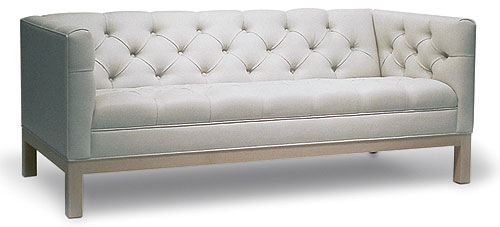

Berkus’s signature sofa is available at Niedermaier
He also designed a sleekly lined furniture collection reminiscent of Paris Moderne style-pieces that are sold exclusively through the Niedermaier furniture show rooms. “They are still available and have always been well received by clients,” says Jeffrey Niedermaier, a vice president of the firm. And Berkus began appearing occasionally on HGTV or DIY design shows; his mother also started turning up on both cable television networks.
In 2001, The Oprah Winfrey Show invited Berkus to redo a viewer’s home. He had 48 hours to redesign a 319-square-foot studio in Boston. “It was intense to say the least,” he recalls with a laugh. The final result included a moss-green-and-sand color scheme with built-in floor-to-ceiling cabinets; a sofa that converted to a bed; a coffee table that also functioned as a wine rack; and a wicker basket side table that held bed linens.
Berkus, with his chic ways and boyish smile, was a hit with both the viewers and Winfrey. A year later, Crain’s Chicago Business included him in its annual review “Forty Under 40,” which spotlights up-and-coming talent in all fields. In Berkus’s write-up, Crain’s noted that he hoped to market his designs for the home with a national retailer such as Target or Home Depot Inc.’s Expo Design Center. “It would be great if everyone had something like a Nate Berkus plate some day,” he said in the article.
* * *
Christmas, 2004. Arugam Bay on Sri Lanka’s eastern coast. Berkus was vacationing with his boyfriend, Fernando Bengoechea, a 39-year-old Argentine-born photographer who specialized in interiors. They had rented a beachfront cottage and were making plans for the day when the deadly tsunami hit without warning. Water started flowing into their room, at one point trapping Berkus under a bed. Then the roof was torn off the cottage, and they were swept into the sea by the wave. They both managed to grab a telephone pole, Berkus would tell CNN the next day, and, though bodies of people and animals and debris from buildings floated past them, they thought they were safe. But then a second wave hit, and they both lost their grip. Berkus managed to climb onto the roof of a house; he ended up spending the night in a field with about 50 other survivors-tourists and locals-who had been caught in the tsunami. Bengoechea was never seen again.
On January 17, 2005, a shaky Berkus appeared on Winfrey’s show to tell his story. It was an unpolished, heartrending rendition-at times, Berkus lost his train of thought as he talked of the devastation he had witnessed; at other moments he teared up-and the show became the most widely watched episode that season. Berkus had given an American face to an unimaginable horror, helping make the tragedy real for people thousands of miles from Asia.
The year 2005 was supposed to be a great one for Berkus. His book, Home Rules, was being published, and most of the photographs had been taken by Bengoechea. His first bedding-and-accessories collection for Linens ‘n Things was due out that fall. But by his own admission later, Berkus was unable to get out of bed at the start of the year. He couldn’t eat, couldn’t even string a sentence together most of the time-an alarming sign for those who knew him best. Unable to function, he soon understood the horrible irony of the situation. Having heard his tale of horror on television, the public was more taken with him than ever. He had always wanted to be famous, and all the pieces-a book, a collection in a national retail chain-were falling into place. Yet all he wanted to do was retreat.
“I have always had a horror of nature, of standing water, of whether or not I would have the strength to survive a physical ordeal, . . . of having a reason to grieve,” he wrote in People magazine a year after the tsunami. Now he had to confront all his fears.
Bengoechea had given him a bracelet that he wears around his right wrist. “It’s from Brazil,” he says as he touches the bracelet. “It’s woven out of the reed that Tarzan would swing on. After the tsunami, my friends and I went online and found the tribe that makes these bracelets, and we had them make as many as they could. Because I never want to not wear one.” By the end of that year, life was returning to normal-“a new normal,” just as Oprah had told him it would.
* * *
He will be the first to admit that not everything he thinks of works out. In fact, sometimes it is a complete disaster. Like the puka-shells fiasco. “I went to Hawaii, and I saw those puka-shell necklaces that sell for a dollar on the beach,” says Berkus. “And when I was little, I thought they were so cool.”
He started thinking that there had to be ways to use puka shells in his home-décor line. He e-mailed Shade, saying, “Puka shells.” She wrote back, “You’re a freak.” But he was not deterred. They went to a Linens ‘n Things production meeting in New Jersey, and Berkus could not stop talking about puka shells. “I saw them inlaid on wooden boxes or encrusted on picture frames,” he says. “I thought maybe they should be on the hem of drapery panels-you know, five rows of them but only the square puka shells for that. I saw puka shells everywhere.”
|
So Linens ‘n Things created samples of items decorated with puka shells, and when the samples were done, a huge box of them was sent to Berkus for his approval. “I’m so excited and I pull out the first item and it is so wrong,” he says. “Puka shells are squished into some kind of ugly gluey thing on a wooden box; the glue has gold glitter in it, and it just looks horrible. So I’m digging through the box”-he starts pantomiming frantic motions, and you can almost see the scene: packing material flying, his hair falling in his face, which is revealing an expression of increasing panic-“and it’s all horrible. Every single thing. Finally I take the approval form I have for each item in the box and I write ‘Yuck!’ across it.
“Later the head of product development calls me and says, ‘It’s always fun to work with you, Nate, but when we send you a big box of items, we expect to get a yes or a no on each individual item.’ Well, you know, it’s a question of time. Should I write, ‘This makes me want to throw up,’ and then ‘I hate this,’ and then ‘How wrong can I be?’ Because I was really, really wrong.”
“You’re a freak,” says Shade.
“It was a moment,” agrees Berkus.
* * *
One thing he knows for sure: “There is no joy like the joy of a label maker,” says Berkus. “That sound of the cutter making that decisive cut of a new label? Isn’t it great?”
He is addicted to neatness. Everything has to be labeled and put away in its own special place. As a kid in the dentist’s office, he would sneak peeks into the labeled cabinet drawers. “It was important to me that the labels were accurate, that the same things named on the labels would be in the drawers,” he says. “And sometimes they weren’t.” He pauses, understanding that he has wandered into an area where not everyone will follow. “OK, I am a little bit obsessive. But I am the same guy who can go to Mexico with a small backpack and wear the same swimming suit ten days in a row.”
Still, at home, he doesn’t want his black T-shirts touching his brown T-shirts. He doesn’t want his V-necks mixed with his round necks. In Chicago, he lives on one floor of a 1920s building with a stunning view of Lake Michigan. His condo has undergone some shifts in décor since he shared it with Bengoechea, and those changes were featured in the “Passages” section of the winter issue of O at Home. Some of the tablescapes may have changed, but the living room and the master bedroom remain anchored by two oversize woven photos of Joshua trees shot by Bengoechea.
Berkus believes in casual elegance. Baskets from Cost Plus are tucked beneath the circa-1950s French consoles. But he uses sterling-silver flatware every day (“You can throw it in the dishwasher-OK, not the knives,” he says) and Frette napkins. Beyond the eclectic mix of objects (a mercury-glass candlestick, seashells, and an Hermès plate), everything is perfectly organized. His sweaters and his T’s are stacked just so.
Even his eggs. He takes them out of the container, cuts the expiration date off the carton, and places that face-down in a glass bowl, then puts the eggs on top. “That way, I can just pick up the bowl and”-he pantomimes-“look at the bottom to read the date.” When the groceries are put away (and only he can do that correctly), all the labels have to be lined up a certain way. His one-bedroom apartment in New York City is so small (just over 500 square feet), he says, that there isn’t room to stack things the appropriate way. It’s killing him that his clothes of different colors have to touch one another.
|
And yet, he claims that there isn’t a piece of furniture in his Chicago home that isn’t “scratched or dinged. It may photograph beautifully, but the scratches and dings are just how I live.” Partly it’s because of his dogs, Henry and Emma. He allows them to jump on the sofa, the antique leather chaise, and the coffee table, and given that they are rambunctious border-collie mixes that he can barely control (the dog whisperer Cesar Millan went on Oprah to show him how to be the alpha male with these dogs, but it didn’t last long), it’s probably a good thing that he has given up the idea of reining them in. “My dogs and people-that’s what matters most in life. Yes, beautiful things are important to me, and when the dogs went through this phase of peeing on the sofa, that was too much and I just couldn’t deal. But in the end, shouldn’t the pecking order be relationships with people or pets first, things second?”
Doesn’t that run contrary to what he does for a living?
“No,” he says. “I want you to value things for the joy and comfort they bring to your life.” Berkus is, after all, feeling Gustavian this spring. He wants that return to simplicity; he wants that sunshine streaming in from every direction. Visions of all the possible American homes turned into Swedish countryside manors fill his mind and, seeing them, he sees a beautiful future. “It’s how I live,” he says. “It’s how I’d like other people to live.”



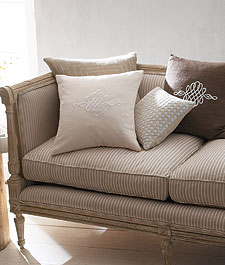 Photograph: Keith Lapinski
Photograph: Keith Lapinski 
 Photograph: Jeff Sciortino
Photograph: Jeff Sciortino
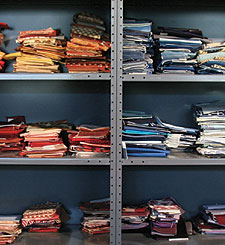 Photograph: Megan Lovejoy
Photograph: Megan Lovejoy 
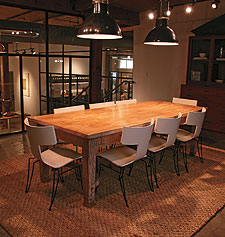 Photograph: Megan Lovejoy
Photograph: Megan Lovejoy 